#tensor chip
Explore tagged Tumblr posts
Text
Pixel 10 pode chegar antes do previsto após dica reveladora do Google
O Google pode estar planejando lançar o Pixel 10 mais cedo do que se esperava. Essa possibilidade surgiu a partir de uma atualização feita pela própria empresa, despertando a curiosidade de fãs e especialistas. A divulgação inesperada sugere que o novo modelo da linha Pixel pode estar mais próximo do que o habitual ciclo de lançamentos indicaria. Indícios de um Lançamento…
#Android puro#chip Tensor#Google Pixel#inteligência artificial#lançamento antecipado#Pixel 10#smartphones Android#tecnologia móvel
0 notes
Text
Ironwood AI Chip: Google’s 7th-gen Tensor Processing Unit

Ironwood, Google's seventh-generation Tensor Processing Unit (TPU), is the first AI accelerator designed for inference and the most scalable and performant.
Google's most difficult AI training and serving workloads have used TPUs for over 10 years, and Cloud customers can too. Ironwood is the most powerful, competent, and energy-efficient TPU. It is also built for large-scale inferential AI models.
Ironwood is a major milestone in AI and its framework. AI models that produce insights and interpret themselves are replacing responsive models that provide real-time information for human interpretation. In the “age of inference,” AI agents will proactively produce and retrieve data to collaboratively deliver answers and insights, not just facts.
Ironwood can manage the huge computational and communication needs of next-generation generative AI. It can support 9,216 liquid-cooled chips linked by 10 MW of revolutionary Inter-Chip Interconnect (ICI) networking. It is one of several unique features of the Google Cloud AI Hypercomputer architecture, which optimises software and hardware for complicated AI tasks. By using Google's Pathways software stack, Ironwood AI Chip lets developers easily and consistently use tens of thousands of Ironwood TPUs.
Ironwood powers the inference age
Ironwood AI Chip handles the complex communication and computation needs of "thinking models," including complex reasoning tasks, Mixture of Experts (MoEs), and Large Language Models. These models require efficient memory access and massive parallel computing. Ironwood is designed to manipulate massive tensors with little data flow and latency. Frontier thinking models demand more processing than a single chip can manage. Google developed Ironwood TPUs with a high-bandwidth, low-latency ICI network for TPU pod-scale synchronous, coordinated communication.
Ironwood comes in 256 and 9,216 chip variants for Google Cloud customers based on AI workloads.
El Capitan, the world's largest supercomputer, delivers 1.7 Exaflops per pod when scaled to 9,216 processors per pod, or 42.5 Exaflops in total. Ironwood can handle 24 times that. Ironwood AI Chip delivers massive parallel computing capacity for the hardest AI tasks, such as ultra-dense LLM or MoE models with thinking skills for training and inference. Each chip is outstanding with 4,614 TFLOPs peak computing. AI technology has advanced greatly. Ironwood's memory and network design ensures data availability for optimal performance at this massive scale.
Ironwood also contains an upgraded SparseCore, an accelerator for ultra-large embeddings common in advanced ranking and recommendation workloads. Ironwood's increased SparseCore support speeds up scientific, financial, and AI workloads.
Google DeepMind's Pathways machine learning software enables distributed processing across several TPU devices. Google Cloud's Pathways make it easy to construct hundreds of thousands of Ironwood AI Chips to swiftly test AI computation limits.
Key Ironwood characteristics
Google Cloud, which integrates AI computing into Gmail, Search, and other services for billions of users everyday, is the only hyperscaler with over 10 years of experience enabling cutting-edge research. Ironwood AI Chip capabilities are based on this experience. Notable traits include:
AI applications are more cost-effective due to performance advancements and power efficiency. Ironwood has double the performance per watt of Trillium, a sixth-generation TPU introduced last year. The offer more capacity per watt for client workloads when power availability limits AI capabilities. Advanced liquid cooling methods and optimised chip design can retain up to double the performance of traditional air cooling under continual, heavy AI workloads. Compared to the 2018 Cloud TPU, Ironwood AI Chip is 30 times more power efficient.
High Bandwidth Memory capacity increases significantly. Ironwood can analyse bigger models and information with 192 GB per chip, six times more than Trillium, reducing data transfers and improving speed.
HBM bandwidth was 4.5 times Trillium and reached 7.2 TBps per chip. For modern AI's memory-intensive operations, this high bandwidth ensures fast data access.
Improved Inter-Chip Interconnect bandwidth. This is now 1.2 Tbps bidirectional, 1.5x faster than Trillium, enabling faster chip-to-chip communication and scaled distributed training and inference.
Ironwood meets tomorrow's AI needs
In the era of inference, Ironwood AI Chip's processing power, memory capacity, ICI networking advances, and dependability are revolutionary. With these advances and a nearly twofold boost in power efficiency, the most demanding clients can now train and serve workloads with the greatest performance and lowest latency while meeting exponential computing demand. Modern models like Gemini 2.5 and the Nobel Prize-winning AlphaFold employ TPUs. When Ironwood launches later this year, we're enthusiastic to see what AI advancements developers and Google Cloud customers will create.
#technology#technews#govindhtech#news#technologynews#Ironwood AI Chip#Ironwood AI#Ironwood#google Ironwood#Inter-Chip Interconnect#Tensor Processing Unit#Ironwood TPUs
0 notes
Text
Google Pixel 11: se revelan los codenames y el Pixel 10a podría revolucionar la tendencia Tensor
Nos están llegando novedades sobre la próxima serie Google Pixel 11, que parece seguir una nueva temática: los osos. Según documentos que han llegado a nuestros oídos, Google está evaluando un enfoque más asequible para su modelo de gama media Pixel 10a, que podría utilizar el chip Tensor G4. Los nombres en clave para la nueva hornada de dispositivos son bastante evocadores. El Pixel 10a será…
0 notes
Text
Google Tensor G3 Chip: The AI Powerhouse Redefining Smartphones
Excited about the Google Tensor G3 chip? Share your thoughts and questions below! Let's discuss the future of mobile AI.
Google Tensor G3 – A New Level of Smartness for Your Smartphone Smartphones are our constant companions, shaping the way we communicate, work, and experience the world. But what if your smartphone could truly understand you, anticipate your needs, and elevate your experiences beyond what you thought possible? That’s where Google Tensor G3 chip comes in – a revolutionary processor that’s not just…

View On WordPress
#ai photography#ai video#computational photography#google assistant#google tensor g3 chip#machine learning#mobile ai#pixel 8#smartphone processor
0 notes
Text
Thoughts and opinion on Switch 2
Before I start, do know I really like tech and generally, I like interesting implemtations of it, so I do have a bias towards handheld consoles in general because they have much more interesting limitations to start with. I'll get all my thoughts, up and down, on the switch 2.
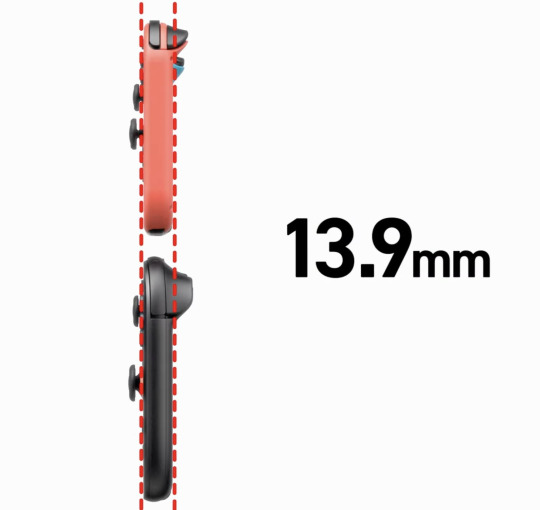
I know the bigger screen does mean more internal area to work with, but how the hell did they manage to keep the thickness nearly identical to the switch 1? Actually impressive, I desperately want to see inside if it is all just because of smaller chip size.
Ok, so where do I properly begin excluding the shock that they pulled off the same thickness? Oh, the screen!
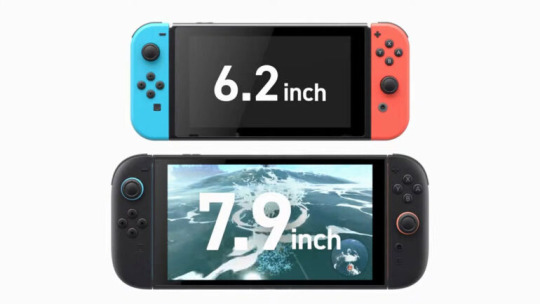
This screen is just a welcome addition overall. 1080p, better brightness and better panel tech that allows for HDR (Microsoft fix your god damn hdr implementation even nintendo has it) while being 120hz and VRR (Nvidia confirmed that it's using their implementation of g-sync via a blog post, here: https://blogs.nvidia.com/blog/nintendo-switch-2-leveled-up-with-nvidia-ai-powered-dlss-and-4k-gaming/). It now matches and slightly exceeds a lot of displays on handhelds now, which funnily enough makes puts it in a similar position as the og switch screen back in 2017, but at least the baseline is much higher so I think this will make the eventual OLED either be more meh, or more better in comparison. It may be closer to the meh side, at least with the first impressions I'm seeing on youtube and seen through my 2013 gaming monitor with clear faded pixels which is it's own issue if I do end up deciding to get a switch 2. Still +$100 I'm calling it. However, the fact it's 120hz natively means that you can now run games at 40fps without screen tearing because it's a clean divisable number of 120, with it looking noticably better then 30fps but not as draining as 60fps or above, which is going to help with more title's battery life. Speaking of Nvidia, let's talk a bit about that blog post.
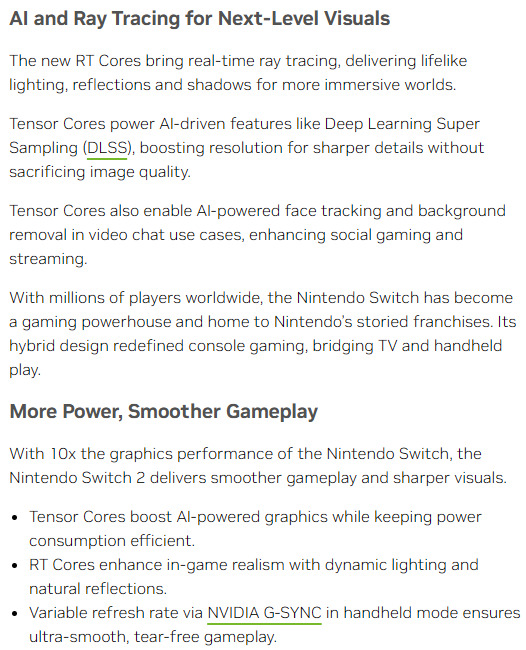
I do not know how much people like this or not (See recent RTX 40xx and 50xx launches to see how happy people are with Nvidia), but I think they are very much the ideal partners in crime with Nintendo this time around. As long as the Tensor hardware is power efficient enough as they claim, this will just be a boon for handheld gaming times, even if they're stuck at the same 2-6.5 hours as the launch model og switch. It also means it can be updated with time to improve games potentially, so if developers decide to take advantage of it and nvidia/nintendo makes it easy to just update the codebase of a game to get to a never version, we may actually have a case of games becoming more performant and/or better looking with time, assuming they are not running at native 4k already. That's neglecting the processing offloading for stuff like that goofy camera, microphone quality and other stuff
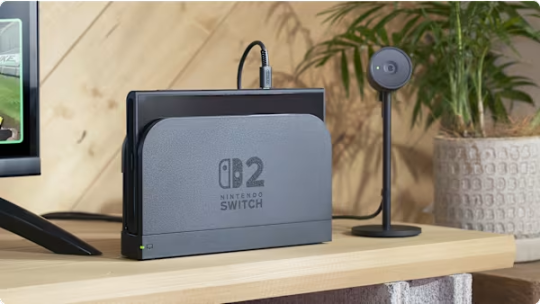
(seriously, if you got a recent enough Nvidia GPU try the Nvidia Broadcast app, it's does basically all the audio/video stuff nintendo showed recently, but now with a focused platform I think this is going to become excellent)
oh ya, it is odd that the stream from friend's framerate is like 12 fps, best guess there is because it uses the on board video encoder and decoded to handle it, and if each is a seperate channel, along with one for background recording/screenshots, plus whatever the games may need for their own dedicated use, I am not too surprised it got the cut on such a slim package. Suck though.
That leads into the dock.
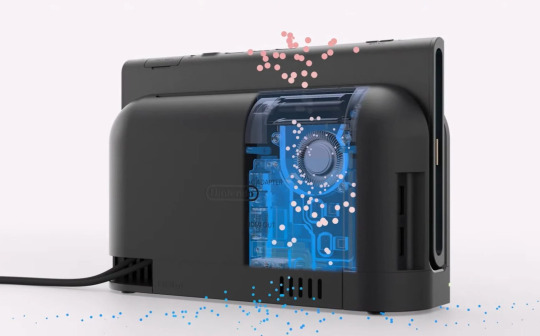
I think the dock is fine. Does the job, has USB ports on the side to connect controllers and charge them (USB 2 tho, so I guess the camera attachement had to go to the top USB C port CORRECTION, I just saw MKBHD's recent switch 2 impression video, it can actually be attached elsewhere maybe. That's interesting, Photo attached below). I think it's as inoffensive as the Switch Oled dock, which does all it needed to do too plus ethernet. It's fine.
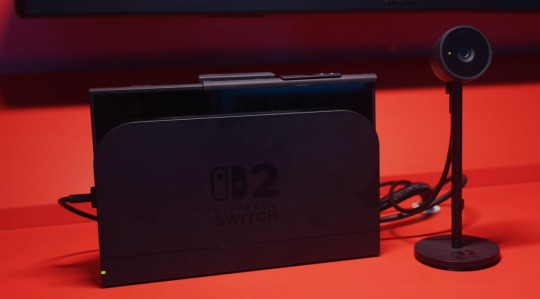
I guess while I'm here, let's touch upon the Microsd Express card slot.
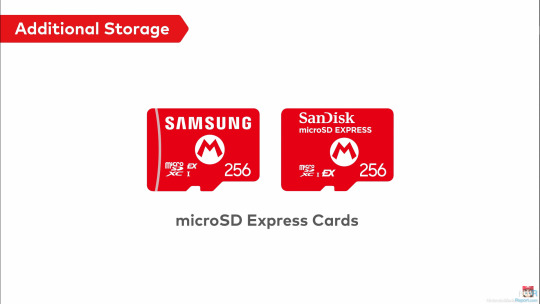
Let me preface this by saying, I knew that the standard was compatible with SD cards of prior so I found it odd they didn't make it clear if it could be used to at least get video/screenshots off, but they did!

Talking about the microSD express cards themselves, I may be in the minority here, but I am very very happy to see this get adopted. For those who are not in the know, it's basically much faster flash (that can be made for slightly more then an normal SD card) that runs off of the reader's PCIe Gen 4, allowing up to 2gb/s of read/write. Which is Crazy, and if they're mandating it to be required for games, that means the current 800mb/s read ones on the market right now is what the console will be using and games will finally load up so much faster. And, unlike the original SD cards, higher capacities like a terabyte already exist AND are not insanely more expensive over base sd cards.(I mean $20-25 for 256gb sd cards to $60 for same but microsd express is still a jump, but do you guys remember how fucking much 256gb sd cards costed originally? It was like $150, and I think 256gb storage will get further milage then the original 32gb storage the og switch had. And 1tb already cost $200 for when it comes out with the switch 2. Those prices will drop unless, uh... not within the scope of what I want to talk about)
Since we're on storage, 256gb of UFS storage? Like on phones, that can go multiple gigabytes per second read/write? Hell ya, we bout to get load times not much worse then other modern consoles.

Let's touch upon the joycons now.
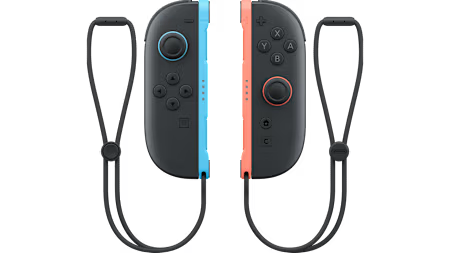
I like them, but as more in a sense of improvment over og switch joycons. Which, honestly, that's all they needed to do. The standout weird feature is the mouse on both, but I only see this as a plus. I want more of my PC games on portable systems, and as much as I want the steamdeck too, the switch form factor is still more portable. Just... please let the bigger joysticks be actually good and resistant to stick drift, I do not want to open them up just to replace the sticks with hall effect ones again. As a plus, I can't wait to see what insanity warioware is going to become now.
Oh ya, chat.
Surprised it took them 2 decades to finally do it, but they seem to have a lot of restraint there still, with extensive parent controls to help metigate any issues, so I'll only give them slightly less shit. Slightly. I'm going to call it though, there is going to be controversy about what eventually will occur over the gamechat. Can't wait!
Switch online services
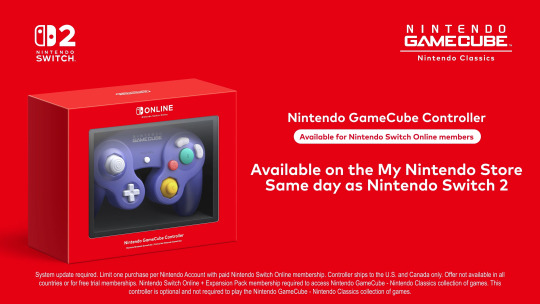
I mean, it was inevitable. This, with the Wii games that's almost absolutely coming later, is going to be good. I suspect a pricebump is going to occur with the NSO that's going to make it cost almost a full game per year, but at least the retro selection is going to start going from crazy to insane, making it probably worth it. I just hope that the voucher program (shown below) gets expanded to more third parties, because as much as I like nintendo games for $50 a piece with this program, it needs to be way more expansive to make the $20 cost at this time to be online, let alone get the 2 vouchers for $100, worth it. If they do that, and keep on adding new actually fun (looking at you Zelda Notes... what the fuck are you) and nice to have to the service, I think it could become worth it in the near future.
I ALMOST FORGOT ONLINE DOWNLOAD PLAY, seriously that alone may be worth it because with both local and online, it means you do not have to force your friends to buy games they may otherwise never touch outside of playing with you. This is straight up a good, pro-consumer thing if others don't ignore it 24/7. I just hope the streaming quality will not be dogshit ahhaha....

(Shout out to nintendo actuallly using this a part to prevent scalpers, I don't like it much because I didn't pay for NSO on the og switch but at least this is a verifiable way to prevent scalpers. I just wish acconts from the Wii U/3ds era got special treatment :^) )

Since we're getting more into software, shout out to how sad the UI is still.

Nintendo, the literal bare minimun here is not just black and white customizable themes. You haven't done that for a generation. I would have much rather had the UI present from the DSi/Wii to Wii U/3ds era then this bland nothing soup. God. Now, onto the most devicive one, and the one that makes or breaks it for me. The games, and their prices.

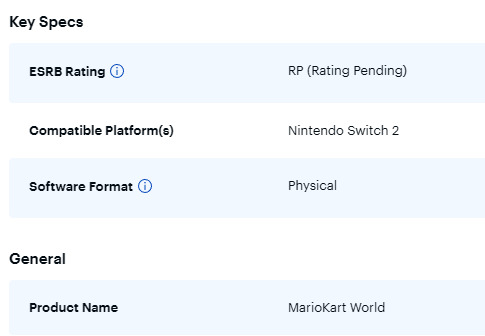
Let's get a few things clear, the $90 physical switch 2 game thing (which I had fallen for too) is in europe. If you're a suffering US citizen, the price is $80 for what seems to be big, high budget nintendo games, with everything else being $70, at least from the list of prices I've seen online.

About Game key cards, ya it's just the 'download play' games on the switch, but instead of a piece of paper that's one time, it's a re-usable cartridge that allows multiple downloads on other switches and acts like a physical one otherwise. This, in my opinion, is objectively better, and is not the default option. Other games will be on the Cartidge like og switch, see Cyberpunk 2077 on a 64gb one (seriously how the fuck they did that).

This switch 2 edition is on a case by case basis, so if it is just an fps/resolution bump, it is likely to be free. If it has a bit more, like some added extras and they know people would pay for the fps/resolution, see botw and totk will be $10, and if the content has basically DLC + all of the above, it's $20. Also, lol at welcome tour.
Seeing all of that, I'm iffy. I'm worried that the panic and reactions from everyone will lock the prices for everyone else at $80 since the publishers will take any chance to push prices up further, but if $70 stays I would reluctantly accept it. Unlike some people on the other platforms may say, in the past before $60 standardization, we had other options to play games like with rental stores, actually being around friends, and frequent discounts and bundles to get inventory moving. That does mean nowadays, especially with no sale nintendo, this price is here to stay, and if this is the cost to actually keep games good and not need astronomical sales to make back development costs, so be it. I am just not happy knowing that a lot of publishers will be using machine created/generated stuff each year for that price or $80 and expect no issues with it. The only thing I am very curious about is the capabilities of the switch 2 being somewhere between a PS4 and PS5, but able to handle PS5 ports, potentially making it the best way to play a lot of newer games on the go until valve decides in 2030 to make the steam deck 2.
Now everyone's favorite issues, price. I think it's reasonable, sucks a bit but reasonable. We're now dealing in a world where Nvidia has their focus on AI stuff, and knows that Nintendo wants backward compat + better stuff, so Nvidia likely is changing way more on parts. This world also includes inflation (seriously, $300 in 2017 is now closer to $400, and now there's all the extra nicer stuff slapped on top to justify a next gen). This world also includes ungodly uncertienty because of a a group in the wrong place in the wrong time. Considering all of this, honestly, $450 is fine. It sucks, I know it has pushed a few friends out from buying it w/o someone assisting them in the purchase, but it's fine. It's going to be a great refinement, which is all a sequel console had to be. The thing you have to know, nintendo is doing the thing again with previous controllers being compatible with the current system, so in reality (especially with me and my hall-effect modded controllers) the price to play with others will not be much more. I touched upon this already, but the game prices are iffy for me, and it's absolutely going to prevent me from buying as many games as I had for the og switch, but it's an dampener.
I will need more time to simmer (and see how my finacial situation is going to be), but I am currently leaning to I will try to get it. I'm on the fence, and I have a good chance of flipping to waiting later, or just not getting.
I may add more thoughts as I think them and remember I can use tumblr like this, but I think this is everything I wanted to get out that has been simmering in my head for a bit. Oh ya I almost forgot the most important thing, Homebrew. I love homebrew, it has given me extra life and enjoyment out of my og switch. If there is another launch edition vuln that allows homebrew, I want in.
16 notes
·
View notes
Text

Switch 2 Technical Specifications?
CPU: Arm Cortex-A78C
8 cores
GPU @ Nvidia T239 Ampere (RTX 20 series)
1 Graphics Processing Cluster (GPC) 12 Streaming Multiprocessors (SM) 1534 CUDA cores 6 Texture Processing Clusters (TPC) 48 Gen 3 Tensor cores 2 RTX ray-tracing cores
RAM: 12 GB LPDDR5, (some/all units will have LPDDR5X chips) Two 6 GB chips
Power Profiles:
Handheld:
CPU @ 1100.8 MHz GPU @ 561 MHz, 1.72 TFLOPs peak RAM @ 2133 MHz, 68.26 GB/s peak bandwidth
Docked:
CPU @ 998.4 MHz GPU @ 1007.3 MHz, 3.09 TFLOPs peak RAM @ 3200 MHz, 102.40 GB/s peak bandwidth
16 notes
·
View notes
Text
@compooterlover I HAVE OFFERINGS!! Leaf doodles and headcanons ft Chip!



Text transcripts [<- is to a drawing on the left, -> is to one on the right.]
1st image:
<- weirdly long
<- gets mistaken for a middle schooler
-> average height boy his age
2nd image:
<- Leaf’s hand is just long
-> will eat anything (he should not)
-> that’s a piece of plastic
<- normal elbow
<- Leaf’s elbow (his legs do the same)
He’s long and probably hyper mobile so other kids are always freaked out by him (esp when he moves)
<- he’s the dedicated periscope
-> spends half his time in braces and Tensor wraps
<- rips clothes with his teeth if they feel bad. He uses the fabric for patches after.
<- hand carved wooden cane because do you think his parents would get him proper aids???
3rd page:
<- grins like this when he sees Chip
Stims with his mouth like this a lot
He also really likes clothes with multiple colours/patterns/fabrics/etc and will often stitch patches onto his clothes for more.
He hates haircuts so he’ll take advantage of his parents’ bad memory to avoid them along with secretly trimming it so they don’t realize.
<- upset because he lost the bee
<- literally just a chill dude most of the time
#if you want more you can send asks or dms or smth#i hâve thoughts about leaf#art#my art#doodles#the 25th annual putnam county spelling bee#25apcsb#25th annual putnam county spelling bee#leaf coneybear#leaf 25apcsb#chip tolentino#25apcsb fanart#25apcsb headcanons
7 notes
·
View notes
Text
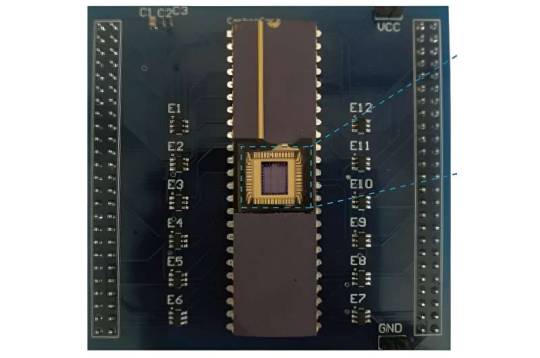
The first tensor processor chip based on carbon nanotubes could lead to energy-efficient AI processing
Artificial intelligence (AI) and machine learning tools have proved to be highly effective in tackling various tasks that entail analyzing data and making accurate predictions. Despite their advantages, these tools have significant computational demands, and when running on existing processing units, they can consume a lot of energy. Researchers at Peking University and other institutes in China recently developed a highly promising tensor processing unit (TPU) based on carbon nanotubes that could be used to run AI algorithms more energy-efficiently. This carbon nanotube-based tensor processing chip, presented in a paper in Nature Electronics, could be a key breakthrough on the path towards developing next-generation chips.
Read more.
#Materials Science#Science#Carbon nanotubes#Nanotechnology#Artificial intelligence#Electronics#Carbon#Nanotubes
14 notes
·
View notes
Text
Grab the Google Pixel Phone for Sale with AI-Powered Features and Stunning Design

Ultimate elegance meets next-level performance with the Google Pixel phone available for sale at Horizon Store. Boasting a sleek Obsidian finish, AI-driven power, and a brilliant 6.3-inch display, it’s your perfect partner for work, play, and everything in between. It captures every detail with its advanced cameras and enjoys smooth multitasking powered by the robust Tensor G4 chip. Don’t miss out—upgrade your tech today!
3 notes
·
View notes
Text
Smartphone Reviews: The Best Devices of 2024
As smartphones retain to adapt, producers are pushing the boundaries of layout, performance, and camera era. With such a lot of options available, selecting the best device can be overwhelming. In this evaluation, we can take an in-intensity take a look at a number of the top smartphones of 2024, covering their specs, capabilities, and overall performance to help you make an informed selection.

Affordable smartphones with best camera reviews
1. Apple iPhone 15 Pro Max
Apple has another time set a excessive bar with the iPhone 15 Pro Max. This device capabilities a titanium frame, making it lighter and extra durable than its predecessor. The A17 Bionic chip ensures pinnacle-tier overall performance, and with a 6.7-inch Super Retina XDR show, the visuals are beautiful.
Key Features:
Processor: A17 Bionic Chip
Display: 6.7-inch OLED (Super Retina XDR)
Camera: Triple-lens machine (48MP foremost, 12MP extremely-huge, 12MP telephoto)
Battery Life: Up to twenty-eight hours of video playback
Software: iOS 17
Pros:
Exceptional camera overall performance, particularly in low light
Impressive battery existence
Premium build exceptional with titanium body
iOS 17 optimizations beautify average usability
Cons:
Expensive
No major layout overhaul from preceding fashions
The iPhone 15 Pro Max is the satisfactory choice for Apple lovers who demand pinnacle overall performance and camera nice. However, its high rate tag may not be for all people.
2. Samsung Galaxy S24 Ultra
Samsung keeps to dominate the Android space with the Galaxy S24 Ultra, a powerhouse of innovation and overall performance. With its Snapdragon eight Gen three processor and an advanced S Pen, this device caters to each productiveness and enjoyment desires.
Key Features:
Processor: Snapdragon eight Gen three (or Exynos variant in pick markets)
Display: 6.Eight-inch Dynamic AMOLED 2X, 120Hz refresh rate
Camera: 200MP major, 12MP ultra-huge, 10MP periscope telephoto, 10MP telephoto
Battery Life: 5000mAh battery with 45W speedy charging
Software: One UI 6 (based on Android 14)
Pros:
Stunning 200MP foremost digital camera for tremendous detail
Bright and vibrant display with a high refresh rate
S Pen support complements productivity
Strong battery overall performance
Cons:
Expensive
Large length won't be cushty for all customers
The Galaxy S24 Ultra is the remaining Android flagship, providing an unheard of camera experience and pinnacle-notch overall performance. However, its high cost and huge shape issue may not match everybody.
3. Google Pixel eight Pro
Google’s Pixel 8 Pro keeps to impress with its AI-powered software program and digital camera skills. The Tensor G3 chip brings AI enhancements that improve pictures, battery control, and standard tool performance.
Key Features:
Processor: Google Tensor G3
Display: 6.7-inch LTPO OLED, 120Hz refresh price
Camera: 50MP major, 48MP ultra-huge, 48MP telephoto
Battery Life: 5050mAh battery with 30W speedy charging
Software: Android 14 (with distinct Pixel functions)
Pros:
Best-in-class computational images
Clean, bloat-loose Android revel in
AI-driven software optimizations
Seven years of software updates
Cons:
Tensor chip nonetheless lags in the back of Snapdragon in raw performance
Slower charging in comparison to competition
The Pixel 8 Pro is the satisfactory choice for folks who prioritize digital camera first-class and a smooth Android experience. While it could now not be the fastest device, its AI features make it a compelling option.
Four. OnePlus 12
OnePlus has been progressively improving its flagship gadgets, and the OnePlus 12 is not any exception. It promises excessive-give up overall performance at a surprisingly lower fee in comparison to different premium flagships.
Key Features:
Processor: Snapdragon eight Gen three
Display: 6.Eighty two-inch AMOLED, 120Hz refresh rate
Camera: 50MP fundamental, 48MP extremely-wide, 64MP periscope telephoto
Battery Life: 5400mAh with 100W speedy charging
Software: OxygenOS 14 (based totally on Android 14)
Pros:
Excellent battery life with excellent-fast charging
High refresh rate display for clean scrolling
Competitive pricing
Minimal software program bloat
Cons:
Camera performance is good however not the pleasant
OxygenOS is turning into greater just like ColorOS
For users who need flagship-level overall performance without spending over $1,000, the OnePlus 12 is a high-quality alternative. It gives fast charging, a brilliant display, and a smooth software program revel in.
Five. Xiaomi 14 Pro
Xiaomi has been making strides within the top class smartphone marketplace, and the Xiaomi 14 Pro is a sturdy competitor. With pinnacle-tier specs and an appealing charge point, it affords super price.
Key Features:
Processor: Snapdragon 8 Gen 3
Display: 6.Seventy three-inch LTPO AMOLED, 120Hz refresh rate
Camera: 50MP predominant, 50MP extremely-huge, 50MP telephoto
Battery Life: 4880mAh with 120W fast charging
Software: MIUI 15 (primarily based on Android 14)
Pros:
Fast charging generation is a few of the quality
Strong performance with Snapdragon 8 Gen 3
High-satisfactory show
Competitive pricing
Cons:
MIUI can sense clutteredreview
Limited availability in some regions
The Xiaomi 14 Pro is a incredible choice for users who need excessive-stop performance at a greater reasonable rate. However, software program enjoy and nearby availability may be factors to don't forget.
2 notes
·
View notes
Text
A Rising Tide of E-Waste, Worsened by AI, Threatens Our Health, Environment, and Economy

The digital age has ushered in a wave of innovation and convenience, powered in large part by artificial intelligence (AI). From AI-driven virtual assistants to smart home devices, technology has made life easier for millions. But beneath this rapid progress lies a less glamorous truth: a mounting crisis of electronic waste (e-waste).
The global e-waste problem is already enormous, with millions of tons discarded every year. Now, with the rapid growth of AI, this tide of e-waste is swelling even faster. Let’s break this down to understand the full scope of the issue and what can be done to mitigate it.
What Is E-Waste, and Why Should We Care?
E-waste encompasses discarded electronic devices — everything from old mobile phones and laptops to smart home gadgets, electric toothbrushes, and even large appliances like refrigerators. It’s not just junk; it’s an environmental and health hazard in disguise.
Each device contains a cocktail of valuable materials like gold and silver, but also toxic substances like lead, mercury, cadmium, and flame retardants. When improperly disposed of, these toxins leach into the environment, harming ecosystems and human health.
A Problem of Global Proportions
Annual Generation: The world generates over 50 million metric tons of e-waste annually, and this figure is projected to grow by 2 million tons each year.
Recycling Rates: Only 17% of e-waste is formally recycled. The rest? It ends up in landfills, incinerated, or handled by informal recycling sectors in developing nations.

While we’re busy marveling at AI-driven innovations, the discarded byproducts of our tech obsession are quietly poisoning our planet.
The Role of AI in Escalating E-Waste
AI, often lauded as the backbone of modern technology, is inadvertently exacerbating the e-waste crisis. Let’s examine the key ways AI contributes to this issue:
1. Accelerating Product Obsolescence
AI-powered devices are evolving at an astonishing pace. Smartphones with AI-enhanced cameras and processors, smart TVs with AI voice assistants, and wearables with health-tracking AI have become must-haves.
But these devices are often rendered obsolete within a few years due to:
Frequent Software Updates: AI systems improve rapidly, making older hardware incompatible with newer software.
Limited Repairability: Many modern gadgets are designed in a way that discourages repairs — sealed batteries, proprietary parts, and inaccessible interiors push consumers toward replacing rather than fixing.
Consumer Demand for New Features: AI advancements create a “fear of missing out” (FOMO), prompting consumers to upgrade frequently.
2. Proliferation of AI-Specific Hardware
AI-driven technologies require specialized, powerful hardware. Graphics Processing Units (GPUs), Tensor Processing Units (TPUs), and custom AI chips are integral to devices and data centers. Unlike general-purpose electronics, these components are challenging to recycle due to their complexity.
3. Growing Data Center Infrastructure

AI thrives on data, which means a relentless demand for computational power. Data centers, the backbone of AI, are:
Upgrading Constantly: To keep up with AI’s demands, servers are frequently replaced, generating massive amounts of e-waste.
Consuming Energy: Outdated hardware contributes to inefficiency and waste.
The Consequences of the E-Waste Crisis
The consequences of unmanaged e-waste are vast, impacting not only the environment but also human health and economic stability.
Health Hazards
E-waste releases harmful substances, including:
Lead and Cadmium: Found in circuit boards, these cause neurological damage and kidney issues when absorbed by humans.
Mercury: Found in screens and lighting, it can lead to brain damage and developmental issues, especially in children.
Burning Plastics: Informal recycling often involves burning e-waste, releasing carcinogenic dioxins into the air.
These pollutants disproportionately affect workers in informal recycling industries, often in developing countries with lax regulations.
Environmental Devastation
Soil Contamination: Toxic metals seep into the ground, affecting agriculture and entering the food chain.
Water Pollution: E-waste dumped in waterways contaminates drinking water and harms aquatic life.
Air Pollution: Incinerating e-waste produces greenhouse gases, contributing to climate change.
Economic Loss
Ironically, e-waste is a treasure trove of valuable materials like gold, silver, and rare earth elements. In 2019 alone, the value of discarded e-waste was estimated at $62.5 billion — higher than the GDP of many countries. Yet, due to poor recycling infrastructure, most of this wealth is wasted.
Turning the Tide: Solutions to the E-Waste Crisis

For Tech Companies
Design for Longevity: Adopt modular designs that make repairs and upgrades easy. For example, Fairphone and Framework Laptop are already doing this.
Reduce Planned Obsolescence: Commit to longer software support and avoid locking critical components like batteries.
Improve Recycling Systems: Implement take-back programs and closed-loop recycling processes to recover valuable materials.
For Governments
Enforce Right-to-Repair Laws: Legislation that mandates access to repair manuals and spare parts empowers consumers to fix devices instead of discarding them.
Promote Circular Economy Models: Incentivize businesses to design products for reuse, repair, and recycling.
Ban Hazardous E-Waste Exports: Prevent the dumping of e-waste in developing countries, where improper recycling leads to environmental and human rights violations.
For Consumers
Think Before You Upgrade: Do you really need the latest gadget, or can your current one suffice?
Repair Instead of Replace: Support local repair shops or DIY fixes with the help of online resources.
Recycle Responsibly: Look for certified e-waste recycling programs in your area.

Can AI Help Solve the Problem It Created?
Interestingly, AI itself could be part of the solution. Here’s how:
Optimizing Recycling Processes: AI-powered robots can sort e-waste more efficiently, separating valuable materials from toxins.
Predicting E-Waste Trends: AI can analyze data to anticipate where e-waste generation is highest, helping governments and companies prepare better recycling strategies.
Sustainable Product Design: AI can assist engineers in designing eco-friendly devices with recyclable components.
A Call to Action
The e-waste crisis is a ticking time bomb, exacerbated by the rapid rise of AI and our insatiable appetite for new technology. But the solution lies in our hands. By embracing sustainable practices, holding companies accountable, and making conscious choices as consumers, we can ensure that the benefits of AI don’t come at the cost of our planet.
It’s time to act, because a rising tide of e-waste doesn’t just threaten the environment — it threatens our future.
#technology#artificial intelligence#tech news#ai#e waste#economy#environment#nature#beautiful planet
2 notes
·
View notes
Text
Vazamento revela novas cores do Pixel 10, incluindo azul, amarelo e verde
O próximo lançamento da linha Pixel da Google ainda nem recebeu um anúncio oficial, mas os rumores já estão agitando o ambiente tecnológico. Recentemente, um vazamento trouxe à tona as cores que estarão disponíveis para o Pixel 10, incluindo suas versões 10 Pro e 10 Pro XL. O que mais chamou atenção foram as novas opções vibrantes e modernas. De acordo com o vazamento, a nova geração do…
#chip Tensor Google#design de smartphones#Google Pixel#inteligência artificial móvel#lançamento 2025#novas cores Pixel#smartphone Pixel 10#vazamento tecnologia
0 notes
Text
Next-Gen Tensor G5 TSMC Powers Google Pixel 10!
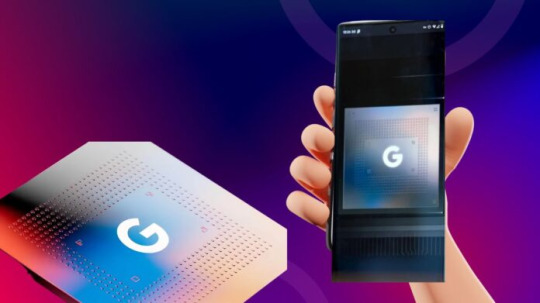
Tensor G5 TSMC
A long-standing tradition will be broken by the processor of the next Google Pixel 10. Samsung Foundry makes Google’s Tensor chips, which power Pixel devices like the Pixel 6. Google may choose TSMC to make its Tensor G5 CPU for the Pixel 10. Google’s hardware aspirations have changed, which could affect the Pixel 10’s performance and capabilities.
Google Tensor G5
Regarding the rationale behind the foundry change, Google has not released an official statement. Still, rumours in the industry suggest a few options:
TSMC’s Leading-Edge Manufacturing
TSMC is the world’s leading chip manufacturer, known for its cutting-edge production procedures. Using TSMC’s 4nm (or possibly a more advanced node) technology for the Tensor G5 TSMC could improve performance and power efficiency over Samsung’s chips.
Supplier Diversification
With Samsung as its only supplier for chips, Google may have been subject to restrictions or limitations resulting from Samsung’s production capabilities or goals. Making the move to TSMC provides production process control and diversification.
Potential Tensions
Unconfirmed, but possible Google and Samsung Foundry may have had underlying conflicts or tensions that affected the choice.
Pixel 10
For the Pixel 10, What Does This Mean?
There have been talks concerning the possible effects of the Pixel 10 after the company switched to TSMC:
Performance Boost
Compared to the 5nm process that is probably utilised in the Tensor chips found in the Pixel 6 and Pixel 7, TSMC’s 4nm process offers efficiency and performance gains. Better graphics performance, quicker processor speeds, and longer battery life for the Pixel 10 could result from this.
Tensor G5’s Capabilities
The features of The Tensor G5 TSMC new chip designs or features may be tested by Google thanks to the move to TSMC, which could have implications beyond the production process. Due to Samsung’s limitations in the past, Google may be able to incorporate features thanks to TSMC’s experience producing cutting-edge chips.
Difficulties to Expect
There may be difficulties involved with moving manufacturing to a new foundry, such as TSMC. At the beginning, there could be delays, yield rates (the percentage of chips that function) or even integration problems.
Improved AI and Machine Learning
Google’s Tensor Processing Unit (TPU) powers the Tensor chip’s machine learning capabilities. Google may benefit from TSMC’s experience in TPU optimisation for on-device AI performance.
Additional Control and Customisation
TSMC might provide Google additional chip design and manufacturing control. This may enable greater Tensor G5 TSMC customisation to meet Google’s needs and Pixel device software optimisations.
A Review of the Data
TSMC may have had some role in the Tensor G5 processor in the Pixel 10, despite the fact that Google hasn’t made the foundry change official. As of right now, we know:
Information Leak
From a publicly accessible trade database, tech publications such as Android Authority have uncovered information suggesting that Google is delivering a new chip possibly the Tensor G5 TSMC from Taiwan, home of TSMC, to an Indian company for testing. Reportedly, TSMC is identified as the manufacturer in the chip description.
Codenames and Speculations
The Tensor G5 TSMC codename, “Laguna Beach,” was also made public by leaks, which solidified the device’s affinity with the Pixel 10. A considerable improvement over earlier Pixel devices may be indicated by the rumours that the chip would have 16GB of RAM that have appeared.
The Way Forward
It will take some time before we witness the tangible effects of Google’s decision to move to TSMC, with the Pixel 9 anticipated to ship later in 2024 and the Pixel 10 most likely arriving in late 2025. Watch out for the following:
Announcements from Google
When the Pixel 10 launches, the company is probably going to announce the foundry partner and give more information regarding the Tensor G5 TSMC.
Benchmark Leaks
Shortly before the official debut, performance benchmarks for Tensor G5 TSMC may surface, providing information about possible gains in performance.
Reviews of the Pixel 10 by tech experts
These reviews will offer practical evaluations of the Tensor G5 TSMC capabilities and its relationship to earlier Pixel models.
Google Pixel 10
The Pixel 10’s transfer to TSMC is notable, but it’s just one part. Expect improvements in other areas like:
Camera Technology
Pixel phones are known for their cameras. This tradition may be continued with the Pixel 10 with upgraded sensors, computational photography, and camera technology.
Display Technology
Flagship phones increasingly have high-refresh rate displays. The Pixel 10 may have a smoother, more responsive display to improve user experience.
Google’s Aspirations for Hardware and the TSMC Factor
The company’s expanding goals in the smartphone hardware market are shown by Google’s decision to switch to TSMC. In order to potentially produce more competitive chips for its Pixel handsets, Google is stepping up its partnership with a top foundry, TSMC. Should this change be effective, Google might become a more significant competitor in the high-end smartphone market, which is now controlled by Samsung and Apple thanks to their proprietary chipsets.
To sum up
Excitement and eagerness have been raised by the impending Pixel 10’s move to a Tensor G5 chip made by TSMC. Even yet, it’s unclear exactly what will happen.
Read more on govindhtech.com
#Tensor#tensorg5#tensorg5chip#chips#TSMC#Hardware#googlepixel10#pixelmodels#pixel#machinelearning#SamsungFoundry#Samsung#news#technews#technology#technologynews#govindhtech
0 notes
Text
Samsung is trying to figure out why it lost Pixel chip production, but we know why
TL;DR Samsung is “intensively analyzing” Google’s switch from Samsung to TSMC for Pixel chip production. The move apparently came as a “shock” to Samsung last month. TSMC is generally considered superior to Samsung when it comes to chip manufacturing. Google has used Samsung to manufacture its Tensor smartphone chips since 2021, but the Pixel 10 series is widely tipped to be made by rival…
0 notes
Text
The Google switched to TSMC for the Pixel 10 chip is a "shock" and a wake -up scene for Samsung
Google’s decision to cooperate with TSMC instead of Samsung to produce the Tensor G5 chip for Pixel 10 is considered a “shock” and a wake -up bell for the semiconductor business of the Korean giant. After many years of cooperating with Samsung to produce Tensor chips for Pixel phones, Google is expected to make a major change. According to the report from The Bell (South Korea), the upcoming…
0 notes
Text
Google shift to TSMC for Pixel 10 chip was a 'shock' to Samsung
According to a new report, Google’s switch from Samsung’s foundry to TSMC for the Tensor G5 chip in the upcoming Pixel 10 series was a “shock” for Samsung, and is serving as a wake-up call for the company’s foundry efforts. For the past few years, Google has been leveraging Samsung to build custom Tensor chipsets for its Pixel devices. It’s been a fairly rocky road, but despite improvements in…
0 notes